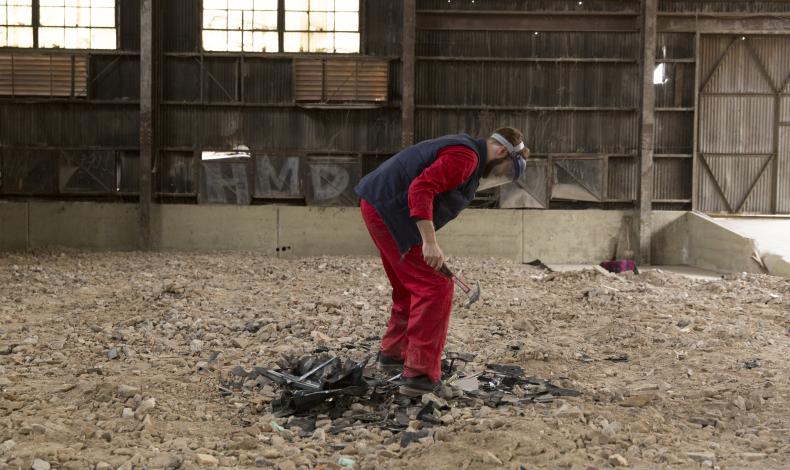Fine Arts Students Complete Mini-Residencies at RAIR

A partnership between the FIne Arts Department and a project called Recycled Artist in Residency, or RAIR, which is housed at Revolution Recovery.
E. Aaron Ross, a first-year MFA student in the Department of Fine Arts, had put in a request for 10 to 15 television sets.
But when he arrived at Revolution Recovery, a recycling facility in Northeast Philadelphia, only three TVs were available. So he improvised. Using a camera rotating around a single TV set, he createda stop-motion animation in which he gradually dismantled the device, making it appear as if the TV was disintegrating. Ross says he likes to work with materials that have “an embedded history within them,” some kind of backstory that’s inseparable from the object itself. So the work, he says, “is always a manipulation of both.”
“I had a couple of ideas, and knew that I would need to be flexible with my ideas upon arriving and seeing what was there,” Ross says.
The project, conceptualized and completed over the course of hours, was one of a handful of mini-residencies carried out by students in the Department of Fine Arts on two Sundays in April.
“They were all site-specific installations that were made out of materials on RAIR’s lot,” says Kristen Giannantonio, coordinator of the undergraduate fine arts program. “Fine Arts instructors prepped the students, gave them a framework of what they would be doing, and developed a curriculum for the day.”
The program is a partnership between the Department and a project called Recycled Artist in Residency, or RAIR, which is housed at Revolution Recovery. RAIR generally offers two types of residencies: A standard program of 1-3 months, and a shorter one that is carried out over 2-4 weekends, which it calls the Biggie Shortie. Because the student residencies lasted only a day, organizers of the program took to calling them “mini-mini-residencies,” or the “Biggie Super Shortie.”
Giannantonio says that a number of Penn faculty and alumni have completed residencies at RAIR in the past. For the one-day student residencies, all MFA students were invited to participate, and a group of undergraduates were handpicked based on their affinity for the type of work completed at RAIR.
In all, seven MFA students and 12 undergraduates chose to join. For the latter, the day included a tour of the facility and both individual and collaborative projects.
The tours were given by Lucia Thomé, director of special projects, and Billy Blaise Dufala, director of residencies and co-founder of RAIR. Thomé says that it was the first time that RAIR had done a partnership of this kind.
“It was an experiment,” Thomé says. “Could we do these really short residencies with students to kind of mimic the experience of being on a residency but on a super-short timeline?”
Thomé suspects that the decision to call the experiment a residency encouraged students to take the project more seriously. For a lot of undergraduates and graduate students, getting an artist’s residency can be an arduous and competitive process. But shrinking the scale of the residency made it more accessible.
“More and more, we’re really trying to get students off of campus and show them different ways and environments of working, because it’s extremely impactful to learn that way,” says PennDesign’s Giannantonio.
Heidi Lee is a junior Fine Arts major in the School of Arts and Sciences with a concentration in product design who’s currently taking studios in painting and screenprinting. She says that being exposed to the materials at RAIR—a lot of which came from demolished homes—made her think about gentrification and redevelopment, not only in Philadelphia but her hometown of Los Angeles. She spent a lot of her time walking around and just looking at the materials: photo albums, couches, refrigerators, bicycles.
“You get these real glimpses of life,” says Lee. “It’s a lot to think about—who these people are and where this material is coming from.”
The residency raised deeper questions for her about the possibilities for art that deals directly with the waste stream, but also about what it means to make art in a socially and ethically responsible way. Both Lee and Ross said they were also inspired by RAIR’s independence. On one level, the residencies were an introduction to RAIR’s work, and an opportunity to think about pursuing longer residencies there down the line, Ross says. But they also took away inspiration for how to envision life as a working artist.
“RAIR created these opportunities and they created these models entirely independently,” Ross says. “There’s something really impressive about thinking about other ways of operating in the world after school.”

